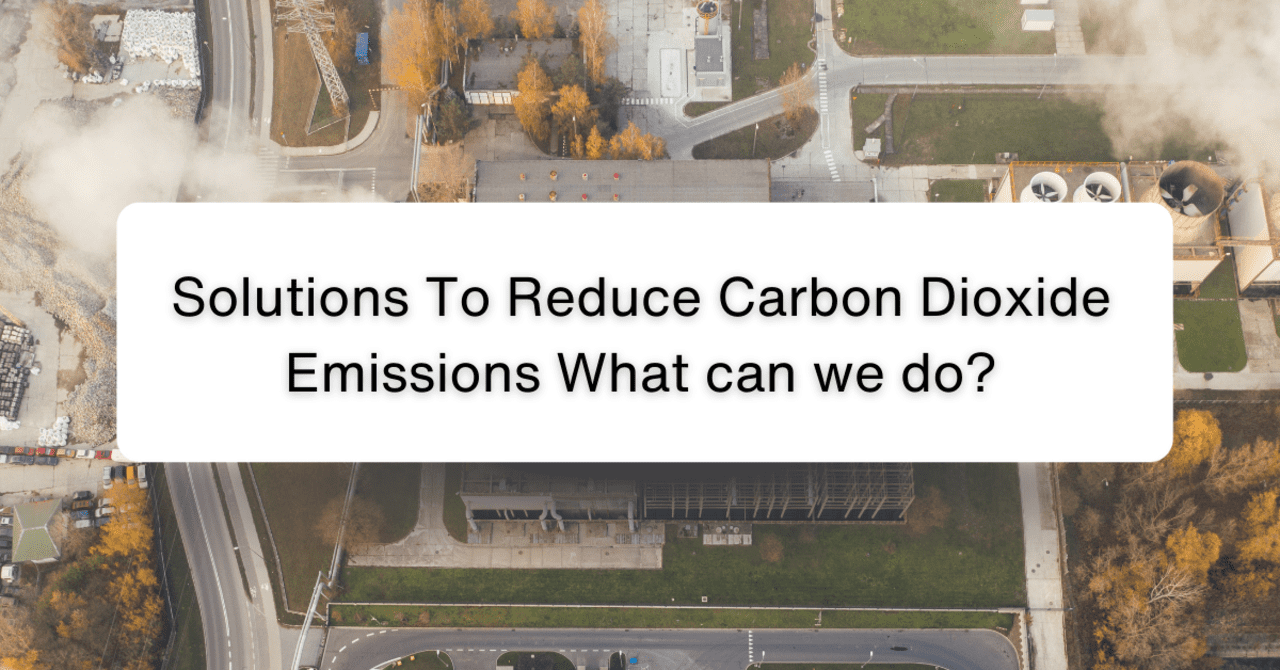Solutions To Reduce Carbon Dioxide Emissions - What can we do?

Carbon dioxide emissions have a profound negative impact on the environment, contributing significantly to climate change and its far-reaching consequences. As individuals, we have the power to take action and implement step-by-step solutions that are easy to apply in our daily lives.
By making conscious choices and adopting sustainable practices, we can play a crucial role in reducing carbon dioxide emissions and working towards a more sustainable future. In this article, we will explore practical solutions to reduce carbon dioxide emissions that anyone can implement, providing a step-by-step guide to make a positive impact on our planet. Let's delve into the solutions and discover what we can do to combat carbon dioxide emissions together.
1. What are Carbon Dioxide Emissions?
Carbon Dioxide (CO2) emissions make up the primary greenhouse gas, which enters the atmosphere as a result of human activities (burning the fossil fuels such as coal, oil, and natural gas).
Carbon dioxide traps heat in the Earth's atmosphere, the main cause of global warming or climate change. The main causes of CO2 includes:
- Energy production: 40% of energy-related electricity production causes carbon dioxide emissions.
- Transportation: Burning gasoline, diesel, and aviation fuels in vehicles, airplanes, ships, and trains.
- Industrial processes: Emissions from chemical reactions during the production of cement, steel, and chemicals.
- Deforestation and land-use changes: When forests are cut down or burned, the carbon stored in trees and vegetation is released as carbon dioxide.
- Residential and commercial sectors: The burning of fossil fuels for heating, cooking, and other activities in homes and commercial buildings.

how much CO2 does the average person emit in Vietnam
2. The impact of carbon dioxide emissions on environment
Over the years, humans have recognized the substantial detrimental effects of CO2 emissions on their planet, prompting them to take action. Despite making concerted efforts across various fronts, carbon dioxide emissions only experienced a slight decrease during the Covid-19 pandemic. Regrettably, the trend continues to move in the wrong direction after that.
Discover the negative impact of CO2 emissions will help us to find the suitable solutions to reduce carbon dioxide emissions.
Climate change: Carbon dioxide is a greenhouse gas that traps heat in the Earth's atmosphere, contributing to the greenhouse effect. As CO2 concentrations increase in the atmosphere, it leads to a rise in global temperatures, resulting in climate change. This can lead to more frequent and severe heatwaves, droughts, storms, and changing weather patterns, affecting ecosystems, agriculture, and human communities.
Ocean acidification: When carbon dioxide is absorbed by seawater, it undergoes a chemical reaction that increases the acidity of the ocean. This process, known as ocean acidification, can harm marine ecosystems, especially coral reefs, shellfish, and other organisms that rely on calcium carbonate to build their shells and skeletons.
Melting ice caps and rising sea levels: Increased global temperatures caused by CO2 emissions contribute to the melting of glaciers, ice caps, and polar ice sheets. This leads to rising sea levels, which pose risks to coastal communities, increase the likelihood of coastal erosion, and impact habitats and ecosystems in coastal areas.
Changes in ecosystems: Climate change resulting from CO2 emissions can disrupt ecosystems and biodiversity. Many species may struggle to adapt to rapid shifts in temperature, rainfall patterns, and ecological interactions. This can lead to changes in the distribution and behavior of plants and animals, impacting food chains, pollination, and habitats.
Health impacts: CO2 emissions, along with other air pollutants released during fossil fuel combustion, can have adverse effects on human health. Poor air quality, exacerbated by high levels of CO2, can lead to respiratory problems, cardiovascular issues, and other health risks.
Feedback loops: Increased CO2 levels can trigger feedback loops that further amplify climate change. For example, as temperatures rise, permafrost (frozen soil) in Arctic regions thaws, releasing trapped methane, another potent greenhouse gas. This can create a positive feedback loop, where increased methane emissions contribute to further warming.
3. Solutions to reduce carbon dioxide emissions by myself
As individuals, optimizing solutions to reduce carbon dioxide emissions is crucial ways to mitigate climate change. Here are some key solutions to reduce carbon dioxide emissions that you can practice step by step:
Reducing energy consumption: If one building implements the saving energy, which encourages sequential activities of others, this will have a huge impact on our planet. Turning off lights and appliances when not in use, using energy-efficient light bulbs and appliances, and optimizing your home's insulation, and temperature settings,... are several easy solutions to reduce carbon dioxide emissions.
Using renewable energy sources: As you know from the definition, CO2 emissions are the result of the overexploitation of non-renewable energy. Therefore, consider switching to renewable energy options such as solar or wind power for your home that can be less dependent on them.
Conserving water: Be mindful of water usage by fixing leaks, using water-efficient fixtures, and minimizing water waste in your household activities. Energy is required to pump, treat, and heat water, so reducing water consumption indirectly reduces energy demand, is one of the effective solutions to reduce carbon dioxide emissions.
Supporting sustainable transportation: Choosing public transit, carpooling, biking, or walking whenever possible,...also contribute to the best solutions to reduce carbon dioxide emissions.
Minimizing air traveling: As you know, air travel is a significant source of carbon emissions despite its convenience. Aircraft engines rely on the combustion of jet fuel, the energy demand of aircraft is much greater than cars or trains… So, trying to limit unnecessary flights and opt for alternative modes of transportation for shorter distances or consider virtual meetings when possible are also the efficient solutions to reduce carbon dioxide emissions.
Choosing plant-based choice: By incorporating more plant-based meals and reducing meat consumption, especially from high-emission sources like beef and lamb, contribute to the solutions to reduce carbon dioxide emissions. This is an interesting fact that you may not have heard before.

Using Bioplastics products: These products use renewable sources or they can be biodegradable, which is a better choice than conventional plastics.
AirX, purchasing the purpose of providing high-quality plant-based carbon negative products, always searching and innovating the technique of bio-based products manufacturing. Our process and materials are ensured to be closely monitored, which adapt the needs of qualified finished products of our customers. Our bio-based materials offer the same functions of conventional plastics, but its environmentally friendly characteristics make them an ideal choice for partners, businesses looking for sustainable development.

Waste reducing and recycling: Minimize waste generation and maximize recycling efforts. Reduce, reuse, and recycle materials to reduce the need for energy-intensive production processes.
Supporting renewable energy policies and initiatives: Stay informed and advocate for policies that promote renewable energy, energy efficiency, and carbon reduction. Support organizations and initiatives that work towards mitigating climate change. If available, you can purchase renewable energy credits or support local renewable energy projects.
Taking urgent action to reduce CO2 emissions is crucial for every individual, organization, and government to prioritize. It represents a small but significant step towards achieving long-term sustainable solutions, such as the ambitious goal of reaching Net Zero achievement.
>>>Learn more: Unveiling Net-Zero Solutions: Transforming Industries for Climate Action
4.Contact us
AirX is the world’s first carbon-negative bio-material made from coffee grounds manufacturer.
We specialize in producing bio-based composites using recycled carbohydrates derived from by-products such as coffee grounds, coconut husk, husk, and bamboo. Our goal is to promote sustainability through the use of eco-friendly materials.
We are always here to help and provide the best service possible. If you have any questions or would like to receive advice and feedback directly from our sales staff, please do not hesitate to contact us. You can reach us through:
- Whatsapp: +84 969 742 950
- Email: [email protected]
We look forward to hearing from you!

